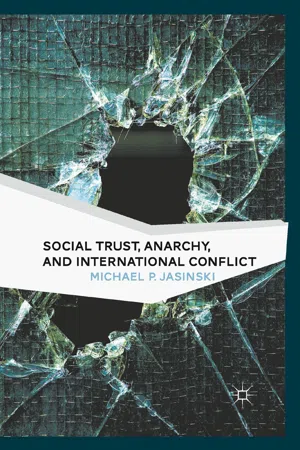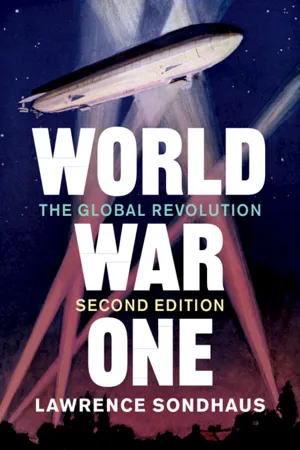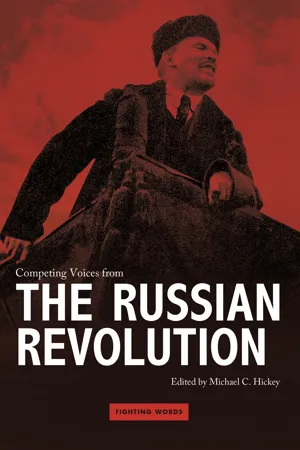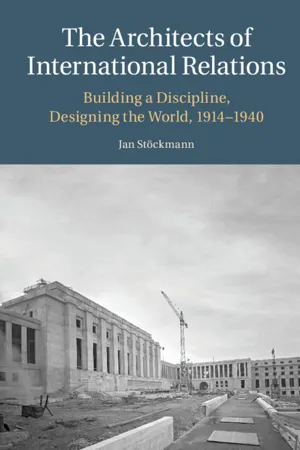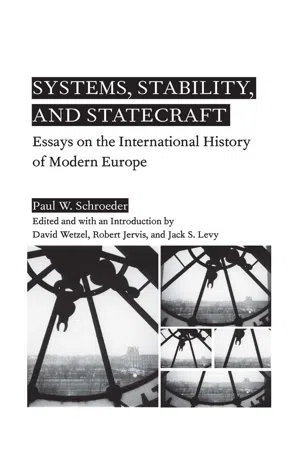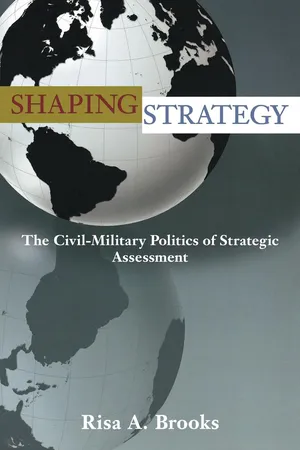History
Causes of First World War
The causes of the First World War can be attributed to a complex web of factors, including militarism, alliances, imperialism, and nationalism. Tensions between major powers, such as Germany, Austria-Hungary, and Russia, were exacerbated by the assassination of Archduke Franz Ferdinand of Austria, ultimately leading to the outbreak of war in 1914.
Written by Perlego with AI-assistance
Related key terms
1 of 5
11 Key excerpts on "Causes of First World War"
- eBook - ePub
Mapping the First World War
The Great War through maps from 1914-1918
- Peter Chasseaud(Author)
- 2013(Publication Date)
- Collins(Publisher)
Chapter 1 The Causes of the WarPosition of the Fleet at Spithead on 24 June 1911.Although the First World War was triggered by a local dispute between Austria–Hungary and Serbia, its origin was an existential struggle between empires. These empires were the German Second Reich, under Kaiser Wilhelm II; the Russian, ruled by Tsar Nicholas II; the Austro-Hungarian Dual Monarchy, held together by Emperor and King (Kaiser und König) Franz Joseph II; and the Ottoman (Turkish), under Sultan Abdul Hamid II but with power increasingly in the hands of the ‘Young Turks’ of the Committee of Union and Progress. On the fringes at the outset, but drawn in by the system of alliances, were the Republican French and monarchical-democratic British Empires. While these two had been traditional enemies for reasons of proximity, religion, maritime and imperial rivalry, this enmity had faded in the face of the growing industrial, military, naval and manpower strength of Germany, which under Wilhelm II demanded its imperial ‘place in the sun’. France and Britain in any case both had their own quarrels with Germany. France burned for la revanche – revenge against Germany for the loss of the provinces of Alsace and Lorraine following the disastrous Franco-Prussian War of 1870–71. Britain resented the deliberate challenge to the Royal Navy, her empire and her trade represented by Wilhelm’s building up of the Kriegsmarine, and also the vain posturing of this upstart grandson of Queen Victoria. - No longer available |Learn more
- (Author)
- 2014(Publication Date)
- College Publishing House(Publisher)
________________________ WORLD TECHNOLOGIES ________________________ Chapter 4 World War I World War I (also known as the First World War , Great War or War of Wars , abbreviated WWI ) was a military conflict centered on Europe that began in the summer of 1914. The fighting ended in late 1918. This conflict involved all of the world's great powers, assembled in two opposing alliances: the Allies (centred around the Triple Entente) and the Central Powers. More than 70 million military personnel, including 60 million Europeans, were mobilized in one of the largest wars in history. More than 9 million combatants were killed, due largely to great technological advances in firepower without corresponding ones in mobility. It was the second deadliest conflict in history. ________________________ WORLD TECHNOLOGIES ________________________ The term World War One is particularly common in American English, whereas in Britain and the The Commonwealth, it is more commonly called the First World War . This term was first coined in 1920 as the title of Charles à Court Repington's book, but references to it being the first war did not become popular until World War II. The terms World War One and Two were first used in Time magazine in 1938. During and in the aftermath of the conflict it was called the Great War , particularly in British newspapers, whereas US media preferred simply the World War . It was also known as the War to End All Wars . The assassination on 28 June 1914 of Archduke Franz Ferdinand of Austria, the heir to the throne of Austria-Hungary, is seen as the immediate trigger of the war. Long-term causes, such as imperialistic foreign policies of the great powers of Europe, such as the German Empire, the Austro-Hungarian Empire, the Ottoman Empire, the Russian Empire, the British Empire, France, and Italy, played a major role. Ferdinand's assassination by a Yugoslav nationalist resulted in a Habsburg ultimatum against the Kingdom of Serbia. - M. Jasinski(Author)
- 2011(Publication Date)
- Palgrave Macmillan(Publisher)
CHAPTER 9 The Outbreak of World War I A rguably the best case study to comprehensively illustrate the dynamics of the impact of the combination of the level of generalized social trust, major power status, and economic growth identified as key factors determining the onset of militarized interstate disputes in the quantitative analyses above is the interaction of European major powers leading up to the outbreak of World War I. With the centennial of the outbreak of the First World War rapidly approaching, it is perhaps appropriate to reflect on the causes of that system-altering conflict, all the more so as many of the factors that contributed to its outbreak persist even to this day. Although the quantitative portion of this project dealt with militarized interstate disputes rather than wars, it must be noted that wars are almost invari- ably preceded by such disputes, which then escalate until they pass the war threshold. Such was the case during the fateful events of 1914. One of these factors is the impact of economic development and interdependence on international conflict. Whereas today, in the era of globalization, there exists considerable optimism that the combination of democracy, universal hospitality, and international institutions (the three components of Kantian peace) have all but banished conflict at least among the states that are well integrated into the international economic system (Jervis 2002), one should not forget that similar predictions were being made prior to 1914. That staggeringly destructive and costly war took place in spite of predictions that such a conflict was extremely unlikely to occur due to the heightened international interdependence caused by the industrial revolution and the expanding international trade fostered by the so-called Pax Britannica, the growing wealth of nations, and the increased costs of major conflict due to a variety of modern technologies (Wolf 2005).- eBook - PDF
World War One
The Global Revolution
- Lawrence Sondhaus(Author)
- 2020(Publication Date)
- Cambridge University Press(Publisher)
1 The World in 1914 and the Origins of the War 1878 Congress of Berlin alters Balkan borders; Ottoman Empire weakened. 1882 Triple Alliance formed (Germany, Austria-Hungary, Italy). 1889–1914 Second Socialist International provides leading forum against militarism. 1892–94 France and Russia conclude military convention and treaty of alliance. 1898 German Reichstag approves “Tirpitz Plan” for naval expansion. 1898 Spanish-American War signals emergence of the United States as an imperial power. 1899–1902 Anglo-Boer War exposes Britain’s isolation; Anglo-Japanese alliance (1902). 1903 Coup in Serbia installs pro-Russian Karageorgevic ´ dynasty. 1904–05 Entente Cordiale links France with Britain. Russo-Japanese War foreshadows trench warfare. 1906 HMS Dreadnought commissioned; Anglo-German naval race accelerates. 1907 Anglo-Russian Entente completes Triple Entente. 1908 Austria-Hungary annexes Bosnia (occupied since 1878). 1911–12 Italo-Turkish War features first combat use of airplanes. 1912–13 Balkan Wars further weaken Ottoman Empire, destabilize region. the world in 1914 and the origins of the wa r 8 The controversy over the origins of World War I began in the summer of 1914, as soon as the declarations of war were exchanged. The decision of the victors to include a war-guilt clause in the Treaty of Versailles reflected their conviction, unanimous as of 1919, that Germany had been responsible for the war. Their verdict was rejected by virtually all German academicians and, during the 1920s, by a broad spectrum of revisionist historians who blamed the alliance system, the great powers collectively, or one or more of the great powers other than Germany. While the experience of World War II refocused the lion’s share of the responsibility on Germany, the scholarship of subsequent decades further explored the roles of all of the belligerents, their domes- tic politics, diplomatic alignments, and war aims as of 1914. - eBook - PDF
Competing Voices from the Russian Revolution
Fighting Words
- Michael C. Hickey(Author)
- 2010(Publication Date)
- Greenwood(Publisher)
It also has important implications for the study of revolutionary social history. One recent study, for example, has argued that during the war peasants developed new ways of thinking and interacting with the state that shaped their views of revolution in 1917 and then influenced their interactions with the Soviet government during the Civil War. 10 15 THE CONTEXT OF WORLD WAR I A Brief Description of Russian Conditions during World War I In July 1914, Tsar Nicholas II decided to mobilize the Russian Army against the Austro-Hungarians. For more than a decade, tensions had been building toward a general European war. The tsar’s declaration— Russia’s response to the complicated diplomatic crisis set off when a Serbian nationalist assassinated the Austrian Archduke Franz Ferdinand in the Bosnian city of Sarajevo on 28 June 1914—brought matters to a head. Germany responded by declaring war on Russia, which set off a chain reaction of war declarations. Dominos set up by prewar alliance systems crashed one upon another: Russia, Great Britain, France, and their allies now were at war against Germany, Austro-Hungary, and their allies (which from 1915 would include the Ottoman Turks). Many of the tsar’s advisors thought Russia simply could not back down from this war, especially given its diplomatic failures since the humiliating Russo- Japanese War of 1904–1905. Most of them believed that the war would strengthen Russia’s position in the European order and reinforce its role as the leader of the Slavic nations. A few expected that war would quell the strikes and student demonstrations that had been building in number and force in the first half of 1914. The conservative official Petr Durnovo, however, had warned the tsar that Russia was ill-prepared for a major war, that Russia’s allies would let it bear the brunt of the conflict, and that the result could very well be collapse and revolution. - eBook - PDF
Justifying War
Propaganda, Politics and the Modern Age
- D. Welch, J. Fox, D. Welch, J. Fox(Authors)
- 2012(Publication Date)
- Palgrave Macmillan(Publisher)
Part II The First World War: Conflict and Aftermath 71 When Sir Edward Grey stared out of the windows of the Foreign Office on the evening of 3 August and remarked, ‘The lamps are going out all over Europe: we shall not see them lit again in our lifetime’, he was reflecting wistfully – but prophetically, as it turned out – on the illusions that governed his diplomacy and his futile attempts to mediate between the continental powers in the July crisis of 1914. For Grey, a political diplomat of the tra- ditional school, it marked a significant turning point from an old to a new world. The following day, The Times on its front page declared: ‘The die is cast. The great European struggle which nations have so long struggled to avert has begun.’ 1 But the proclamation of war for many Europeans, in contrast to the British Foreign Secretary, represented a major turning point and proved to be an exhilarating experience. The German industrialist and statesman Walter Rathenau recalled ‘It was the ringing opening chord for an immortal song of sacrifice, loyalty and heroism … great and unforgettable.’ 2 The First World War holds a unique position as the milestone by which the heroism, brutality and futility of industrialized modern warfare has come to be measured. Having begun with the promise of individual honour and nationalistic glory, it ended after four bloody years of trench, air and naval warfare with much doubt as to whether the sacrifices had been justi- fied and worthwhile. As Philip Taylor has observed, it is often viewed by the victorious powers as an ‘end of innocence’ or a ‘rite of passage ‘into the modern world’. 3 Surprisingly, however, the War had seemed to creep up, unexpectedly, on the people of Europe in July 1914. Following the assassina- tion of Archduke Ferdinand on 28 June, a few signs of a looming crisis can be discerned. - eBook - PDF
The Architects of International Relations
Building a Discipline, Designing the World, 1914-1940
- Jan Stöckmann(Author)
- 2022(Publication Date)
- Cambridge University Press(Publisher)
57 Edgard Milhaud, Plus jamais! L’organisation de la paix, le pacte de la Société des nations, les amendements nécessaires (Geneva, 1919), p. i. 58 H. N. Brailsford, The Origins of the Great War (London, 1914). Understanding the Causes of War 39 newspaper articles in Der Krieg und die Große Politik (1917), and Helena Swanwick’s essay Women and War (1915). They wrote from different angles and employed different styles but essentially pursued the same research goal – to understand, by rational inquiry, the causes and patterns of the current war. In doing so, they associated themselves with an emerging network of scholars, politicians, journalists, activists, and philanthropists who subsequently set up the first IR institutions. In other words, the war jump-started the development of IR as a new academic field. The most striking argument in this emerging literature was that the war had been caused by a flawed system of international politics. Until 1914, the critics argued, foreign policy had been in the hands of govern- ments unaccountable to parliamentary control. International treaties had been kept secret and diplomatic services had recruited their officials from a small elite. Virtually all decision-makers were white men. The ruling class regarded war as a “pleasure party” (Lustpartie), to use Immanuel Kant’s words. 59 While the lack of democratic control was obvious in the case of Germany, none of the belligerent governments was particularly open for dissent either. Nor did the dissenters stand much of a chance. The British, for example, imprisoned E. D. Morel for sending pamphlets to French writer Romain Rolland in neutral Switzerland. By loosely referring to France and Britain as “the democ- racies”, historians have neglected the effects of female disenfranchise- ment, censorship, and the intimidation of the opposition. - eBook - PDF
Systems, Stability, and Statecraft
Essays on the International History of Modern Europe
- P. Schroeder(Author)
- 2016(Publication Date)
- Palgrave Macmillan(Publisher)
Thus the search for the fundamental cause of World War I is futile, while the argument that the war simply happened is unhelpful. Is there no exit from the cul-de-sac? A different question may help: not "Why World n" but "Why not?" War was still the ultima ratio regum. World War I was a normal development in international relations; events had been building toward it for a long time. There is no need to explain it as a deviation from the norm. In this sense, the question "Why notr" answers the question "Whyr" More important, it points to what is unexpected about the war and needs explanation: its long postponement. Why not until 1914 r This question clearly needs answering in regard to Austria. Historians continue to exercise themselves over why the Austrian Monarchy risked its own destruction by insisting on punishing Serbia. The favorite (and very unsatisfactory) answer is that this was the kind of futile, absurd action to be expected from so decrepit an empire with so inept a ruling class. In fact, the problem is nonexistent. Preventive wars, even risky preventive wars, are not extreme anomalies in politics, the sign of the bankruptcy of policy. They are a normal, even common, tool of statecraft, right down to our own day. British history, for example, is full of them; the British Empire was founded and sustained in great part by a series of preventive and preemptive wars and conquests. As for the particular decision oOune 1914, the evidence is plain that Berchtold, although often wavering, resisted the idea of a punitive war on Serbia until the assassination. With the death of Francis Ferdinand, leader of the peace party, Berchtold simultaneously ran out of alternatives, arguments, and sup- port for any other policy, and gave in. 9 The real problem is to explain why Austria waited so long and tried so many other futile devices to stop the steady deterioration of her Balkan and great power position before resorting to force. - eBook - PDF
The Great War in History
Debates and Controversies, 1914 to the Present
- Jay Winter, Antoine Prost(Authors)
- 2020(Publication Date)
- Cambridge University Press(Publisher)
Continuities While a number of historians have widened the geographical and tem- poral definitions of the Great War, the majority of works published since 2000 have continued to deepen our understanding of the military, the political, the economic, the social, and the cultural history of the war. Most adopt the national framework which still dominates First World War studies as a whole. Military history No one has advanced the military history of the First World War more than Hew Strachan, whose first volume of the new Oxford history of the war, To arms!, was published in 2000. In this work he set a new standard 222 The Great War in History for the weaving together of the political, strategic, and operational histo- ry of the war, through the use of German, English, and French sources. This part of his multi-volume history covers 1914. Given the sheer size of the literature and archives related to the rest of the war, it is not sur- prising that Strachan’s project remains incomplete. Military historians have made major contributions to our understand- ing of the fate of individual campaigns. Robin Prior (2009) established the hopelessness of the plan to force the Dardanelles and then to seize the heights commanding the Straits through an amphibious landing in April 1915. Paul Jankowski in 2013 and Antoine Prost and Gerd Krumeich in 2015 broke new ground in the literature about Verdun. Jankowski sug- gested that Falkenhayn never saw Verdun as a breakthrough battle, but a violent prelude to what would have been a later attempt to breach Al- lied lines. Prost and Krumeich showed why the French withstood Falk- enhayn’s assault at Verdun in 1916, through an original analysis of the workings of the French general staff. William Philpott (2009) provided the first full account of all three armies engaged in the Battle of the Somme later that year. - eBook - PDF
Pandora’s Box
A History of the First World War
- Jörn Leonhard, Patrick Camiller(Authors)
- 2018(Publication Date)
- Belknap Press(Publisher)
And the lingering effects of the war included the army of wounded and the need for long-term public provision for war invalids. It was they who gave a face to the war in peace. The war had revealed what was possible in the name of the nation and nation-state, and what was possible had become evident in the widespread breaking of taboos and loss of inhibitions. A specific kind of “European social-ization,” which had developed since the late seventeenth century against a background of religious civil wars, was entering into crisis.2 That order had been based on the idea of a set of rules to regulate wars, to prevent conflicts from escalating between sovereign states, to channel violence and make it calculable. After the experiences of the French Revolution and the Napole-onic Wars, this order had again been operative in the period between 1815 and 1914—and for a long time the international order had proved flexible in Burdens | 893 adjusting to new nation-states and imperial outreach. But that epoch came to an end with the First World War. Between August 1914 and November 1918, European countries lost the ability to achieve external and internal peace on their own or to trust that it would continue in the long term. This marked a watershed in the global perception of Europe and the credibility of the international model represented by its states. The victor of the world war was not a nation, a state, or an empire, and its outcome was not a world without war. The true victor was war itself— the principle of war and the possibility of total violence. In the long run, this weighed all the more heavily because it contradicted a leitmotif that had developed during the war and had for many been a decisive reason to continue it with all possible means. - eBook - PDF
Shaping Strategy
The Civil-Military Politics of Strategic Assessment
- Risa Brooks(Author)
- 2018(Publication Date)
- Princeton University Press(Publisher)
Many scholars in this vein analyze the long-term political and social conditions in Germany that inspired its international ambitions and insecurities. 64 As such, this research focuses on broader issues that led inevitably to armed conflict and not necessarily on actual decision making in Germany (Wilson 1995: 4). A more narrowly defined literature emphasizes actual decisions for war, and specifically those decisions in the July 1914 crisis (Hewitson 2000: 571). Here debate turns on the motives, meanings, and significance of actions of particular individuals—especially Kaiser Wilhelm I I , Chancel-lor Bethmann Hollweg, War Minister Erich von Falkenhayn, Chief of Staff Helmuth von Moltke, as well as their Austrian counterparts—at various points in July and early August (Joll 1984; Geiss 1967; Albertini 1953; Wilson 1995; Schmidt 1990; Tuchman 1962). One conventional view within this scholarship has long been that the war was inadvertent—the product of inflexible military plans and mobilization schedules, the short 6 3 Striking is the degree to which in Copeland's (2000) fascinating account of the July 1914 crisis, extremely complicated strategies by German leaders to achieve an ambitious set of political and military objectives were little debated and pursued as if self-evident, despite their reliance on a range of contingencies and actions by other states sometimes inconsistent with their self-interests. 6 4 Key themes include the role of social Darwinism (Kaiser 1983), the economy and con-straints on military spending (Ferguson 1992), popular opinion (Mommsen 1973), and the international situation (Schollgen 1990). 180 C H A P T E R F I V E war allusion, and militarism. Scholars in this tradition also almost univer-sally emphasize the confused and idiosyncratic nature of assessment in Ger-many during the July crisis. Two themes emerge within the historical literature that might account for these weaknesses in Germany's evaluative processes.
Index pages curate the most relevant extracts from our library of academic textbooks. They’ve been created using an in-house natural language model (NLM), each adding context and meaning to key research topics.


